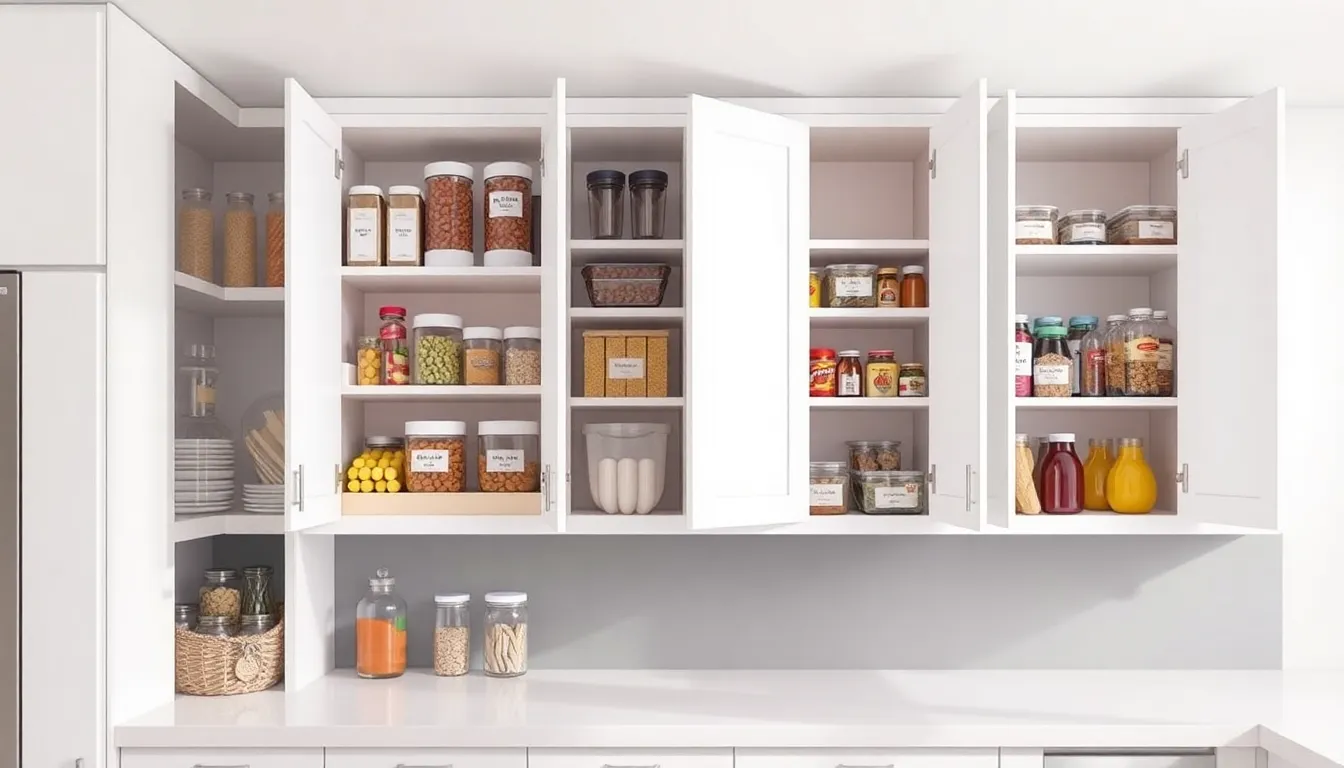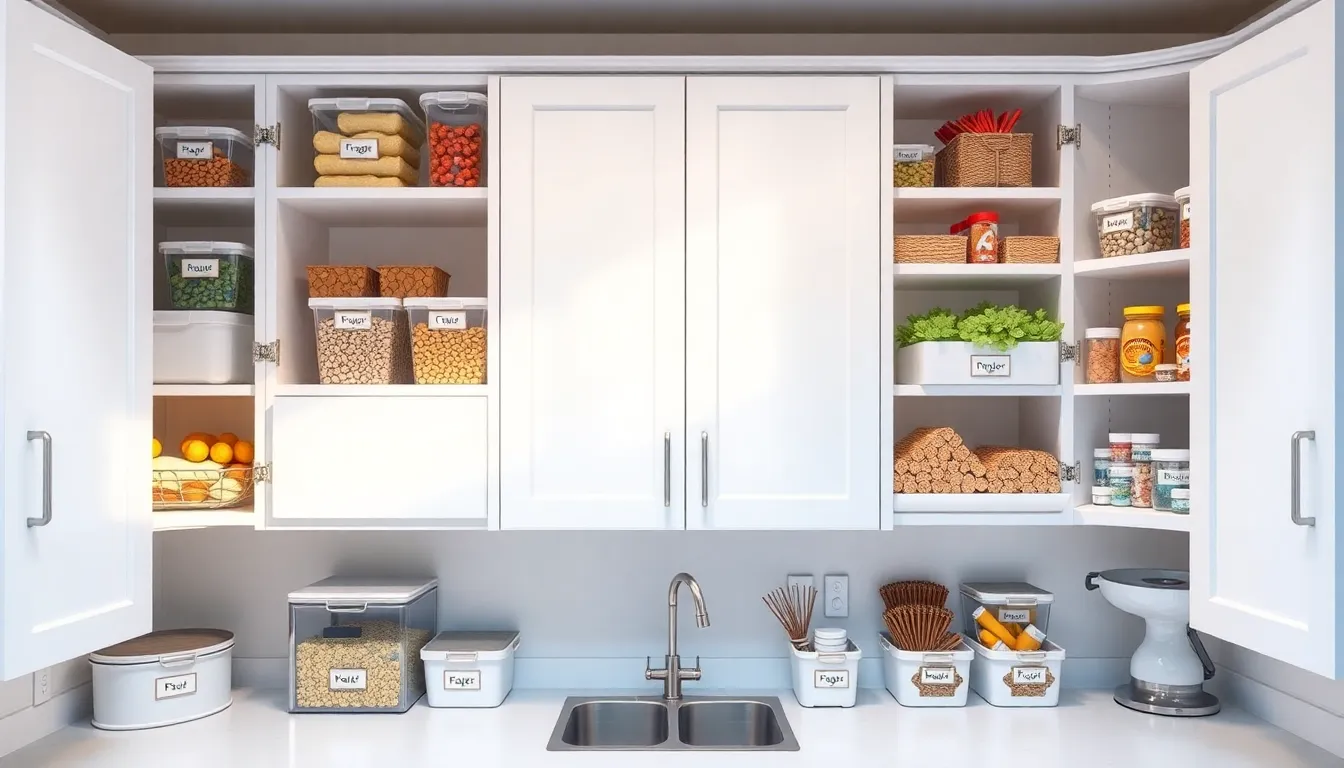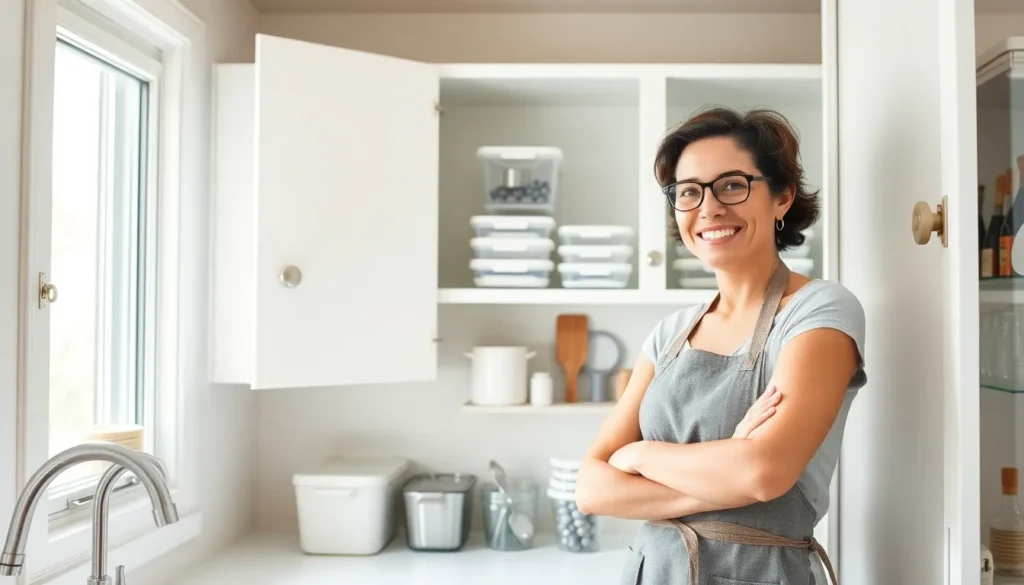Table of Contents
ToggleEver opened a kitchen cabinet only to be greeted by an avalanche of pots, pans, and mystery Tupperware? It’s a scene straight out of a cooking horror movie. But fear not! Organizing your kitchen cabinets doesn’t have to be a nightmare. With a pinch of creativity and a dash of strategy, you can transform your cluttered chaos into a culinary oasis.
Kitchen Cabinet Organizing Ideas
Maximize space by utilizing pull-out shelves. These shelves enhance accessibility and visibility of kitchen items. Consider adding tension rods inside cabinet doors. This strategy allows for easy access to lids and cutting boards while keeping them neatly organized.
Grouping similar items simplifies finding necessary tools. Store baking sheets and pans in a designated section to maintain order. Utilizing stackable containers optimizes vertical space, reducing clutter. It makes sense to label bins for clear identification of contents.
Adjustable shelving provides flexibility. This feature accommodates various sizes of dishes and cookware effortlessly. Integrate drawer dividers to separate utensils and cooking gadgets. This method minimizes chaos during meal prep.
Incorporate clear containers when storing pantry staples. Visibility allows for quick inventory checks, preventing overbuying. Rotating items based on usage frequency increases efficiency. Keep frequently used items at eye level to streamline access during cooking.
Use magnetic strips for secure storage of knives and metal utensils. This solution prevents drawer clutter while keeping tools easily accessible. Install a pegboard for hanging pots, pans, and cooking utensils to free up cabinet space.
Maintain organization by conducting regular decluttering sessions. Schedule them quarterly to ensure cabinets remain tidy and functional. Focus on eliminating rarely used items to enhance space efficiency.
Investing in specialized organizers tailored to specific items maximizes kitchen functionality. Under-sink organizers effectively store cleaning supplies, keeping them out of sight yet accessible. Consider integrating tray organizers for dishes and glassware, promoting an orderly appearance.
Benefits of Organizing Kitchen Cabinets


Organizing kitchen cabinets offers numerous advantages. Efficiency and aesthetic appeal top the list.
Improved Efficiency
Organized cabinets enhance efficiency during cooking and meal prep. A clear layout helps locate tools quickly. For instance, using labeled bins allows for easy identification of ingredients. Easy access to commonly used items minimizes time spent searching. Grouping similar items boosts productivity by reducing clutter. Well-organized spaces decrease frustration, enabling smoother workflows. Pull-out shelves provide better access and visibility to items. Creating zones for different tasks streamlines the cooking process significantly.
Aesthetic Appeal
A well-organized kitchen visually enhances the space, creating a more inviting atmosphere. Beautifully arranged shelves add charm to the kitchen’s overall look. Neatly stacked containers contribute to a clean appearance. Transparent storage options showcase colorful pantry staples, adding vibrancy. Incorporating decorative organizers elevates the style quotient, turning functional areas into design elements. An organized kitchen cabinet not only looks pleasant but also reflects personal taste. Cohesive colors and aesthetics promote harmony throughout the kitchen space. The overall effect results in an environment that’s enjoyable to spend time in while cooking or entertaining.
Essential Tools and Supplies
Having the right tools and supplies makes organizing kitchen cabinets easier. Essential items help streamline the process and contribute to a tidy space.
Organizers and Bins
Storage bins and organizers play a crucial role in maintaining order. Divided bins work well for grouping similar items, while stackable options maximize vertical space. Drawer organizers ensure easy access to utensils, preventing clutter. Clear bins allow visibility of contents, simplifying inventory checks. Dish racks keep plates and bowls neatly arranged, freeing up cabinet space. Using tiered shelves increases accessibility for frequently used items. Implementing these tools enhances efficiency during meal prep.
Labels and Markers
Labels and markers help identify the contents of bins and organizers. Clear labeling eliminates the need to search for items, speeding up cooking time. Use waterproof labels for durable and easy cleaning. Organizing pantry staples by category simplifies restocking. Color-coded labels can visually appeal and differentiate between various groups. A label maker streamlines creating consistent tags. Consistent use of markers ensures easy identification of containers, making the kitchen feel more organized and inviting.
Creative Organizing Strategies
Transforming kitchen cabinets into functional spaces requires innovative strategies. These methods help maximize efficiency and enhance accessibility.
Use of Vertical Space
Utilizing vertical space proves essential in kitchen cabinet organization. Shelves that extend higher allow for stacking containers and maximizing storage capacity. Install shelf risers for optimal space usage, making lesser-used items easily accessible. Consider adding hooks beneath shelves for hanging lightweight tools, such as measuring cups and spatulas. Vertical dividers effectively separate baking sheets or trays, streamlining organization and improving visibility. Having clear containers helps quickly identify contents, contributing to an orderly look. Each of these items increases both storage efficacy and ease of access, making the kitchen more user-friendly.
Drawer Dividers and Inserts
Drawer dividers and inserts create organized compartments that enhance kitchen efficiency. These tools effectively separate utensils, enhancing accessibility during cooking. Adjustable dividers allow customization, accommodating various items such as flatware or cooking utensils. Inserts designed for specific tools streamline functionality, ensuring that everything has its place. Using shallow containers for smaller items prevents clutter from accumulating, leading to a smoother cooking experience. Every organized drawer contributes to a more enjoyable and efficient kitchen environment, reflecting a systematic approach to organization.
Maintenance Tips for Organized Cabinets
Maintaining organized cabinets involves routine care and smart practices. Schedule regular decluttering sessions every three months to remove expired items and unnecessary clutter. Utilize a system that allows for easy rotation of pantry staples, ensuring newer items stay at the back.
Organize seasonal tools and appliances by evaluating their usage frequency. Store seldom-used items further back or on higher shelves, while keeping frequently used ones at arm’s reach. Evaluate the contents of each cabinet periodically, adjusting organization methods based on changing cooking habits and preferences.
Invest in clear containers that allow for quick visibility of contents. Label bins and shelves with waterproof labels for easy identification and simpler restocking. Keep a list of pantry items on the inside of cabinet doors to track inventory.
Incorporate drawer organizers that adapt to different item sizes, preventing clutter from building up. Aim to create a specific storage space for each category, such as cooking utensils, spices, or dishware.
Utilize airtight containers for perishables, enhancing preservation and keeping out pests. When stacking containers, place heavier ones at the bottom to prevent them from toppling. Store cutting boards and lids on tension rods affixed inside cabinet doors for easy access.
Assess the need for specialized organizers based on individual needs, like under-sink units for cleaning supplies or tray organizers for dishes. Prioritize maintaining an organized kitchen space that reflects personal style, fostering a welcoming environment.





